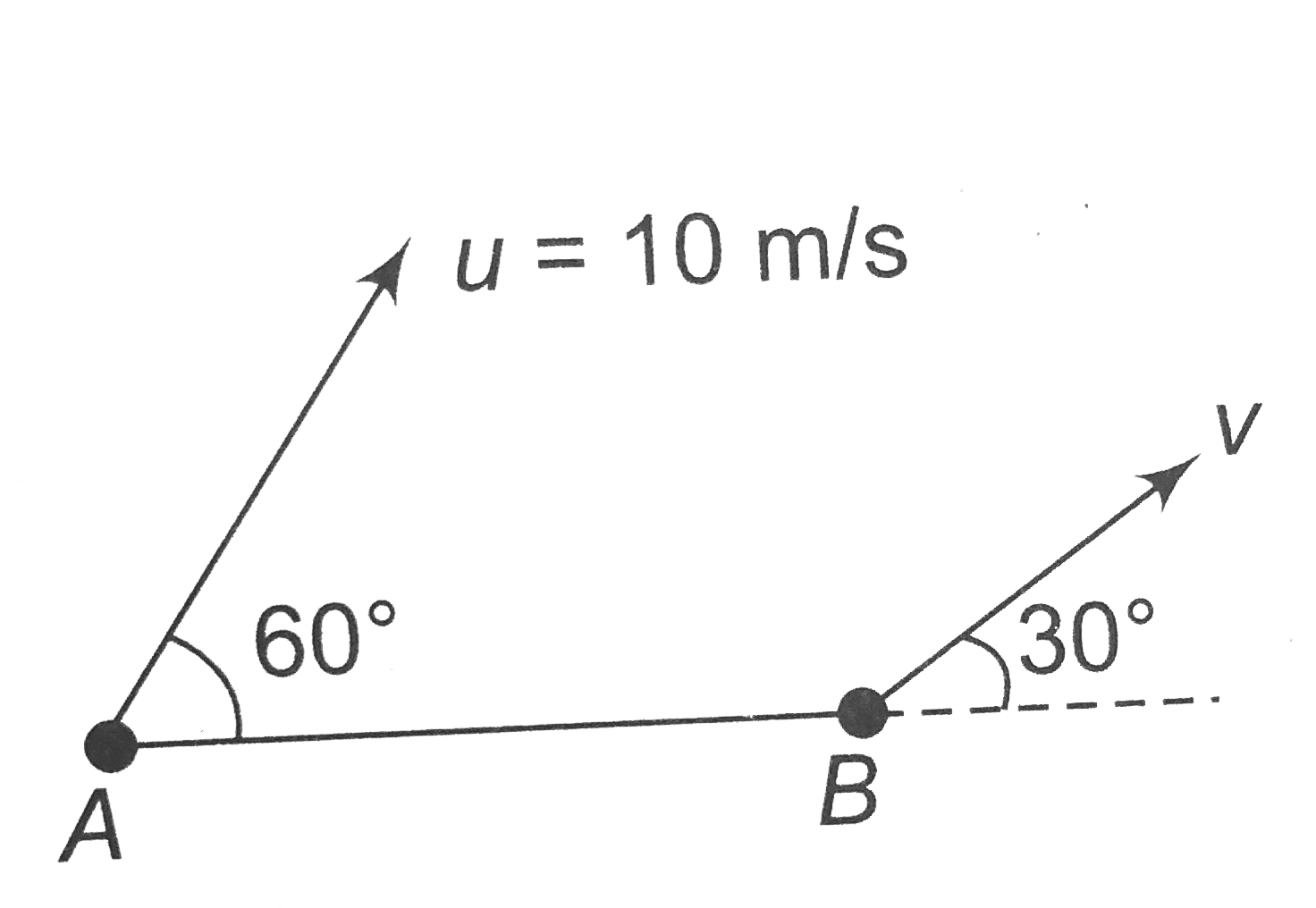Two particles A and B are situated at a distance d=2m apart. Particle A has a velocity of 10m/s at an angle of 60∘ and particle B has a velocity v at an angle 30∘ as shown in figure. The distance d between A and B is constant. the angular velocity of B with respect to A is :
 .
.
5√3rad/s
5√3rad/s
10√3rad/s
10√3rad/s
The correct Answer is:B
(b) If distance between them remains constant, then vcos30∘=ucos60∘
⇒v√32=1012⇒v=10√3
ω=vsin30∘−usin60∘)/d
=10√3×12−10×√322=−5√3rad/s.
Topper's Solved these Questions
- ROTATIONAL DYNAMICSBook:A2ZChapter:ROTATIONAL DYNAMICSExercise:Torque , Torque Equation And Equilibrium Of A Rigid Body
Explore 29 Videos
- ROTATIONAL DYNAMICSBook:A2ZChapter:ROTATIONAL DYNAMICSExercise:Angular Momentum And Its Conservation
Explore 30 Videos
- ROTATIONAL DYNAMICSBook:A2ZChapter:ROTATIONAL DYNAMICSExercise:Moment Of Inertia
Explore 39 Videos
- PROPERTIES OF MATTERBook:A2ZChapter:PROPERTIES OF MATTERExercise:Chapter Test
Explore 29 Videos
- THERMAL PROPERTIES OF MATTERBook:A2ZChapter:THERMAL PROPERTIES OF MATTERExercise:Chapter Test
Explore 30 Videos
Similar Questions

A particle is given velocity v0 at point A as shown in the figure. Find the speed of particle at point B,C and D
View SolutionTwo Particle A and B are moving with uniform velocities of 20m/sec and 10m/sec as shown in the shown in the figure. The Magnitude of angular velocity of A with respect to B.when their separation (AB) is 10 meter is
View Solution
Knowledge Check
If a particle A is moving along a straight line with velocity 3m/s and another particle B has a velocity 5m/s at an angle of 60∘ to the path of A then the velocity B relative to A is
Asqrt(39)m/sB√19msC19m/sDnone of the aboveIf a particle A is moving along a straight line with velocity 3m/s and another particle B has a velocity 5m/s at an angle of 60∘ to the path of A then the velocity B relative to A is
Asqrt(39)m/sB√19msC19m/sDnone of the aboveTwo moving particles P and Q are 10 m apart at a certain instatn. The velocity of P is 8 m/sm making an angle of 30∘ with the line joining P abd Q and that of Q is 6m/s making an angle 30∘ with PQ as shwon in figure.

Then, angular velocity of P wiht respect to Q isAzeroB0.1rad/sC0.4rad/sD0.7rad/s
Two particles A and B are initially 40mapart, A is behind B. Particle A is moving with uniform velocity of 10ms−1 towared B. Particle B starts moving away from A with constant acceleration of 2ms−1.
The minimum distance between the two is .
View SolutionTwo moving particles P and Q are 10 m apart at a certain instant. The velocity of P is 8 m/s making 30º with the line joining P and Q and that of Q is 6 m/s making an angle 30º with PQ as shown in the firuge .Then angular velocity of P with respect to Q is-

View SolutionTwo particles A and B are located at point (0m,50m) at t=0. The particle A moves withy a constant velocity and the particle B moves on a circle of radius 50 m having centre at origin (0,0) as shown in figure. The pasrticle B has a constant speed 5πm/s. What will be the velocity of particle A so that both the pasrticles reach at point (50m,0m) simultaneously.

View SolutionA particle is moving on a circular path with constant speed v then the change in its velocity after it has desceibed an angle of 60∘ will be
View SolutionParticle A moves along X-axis with a uniform velocity of magnitude 10 m/s. Particle B moves with uniform velocity 20 m/s along a direction making an angle of 60° with the positive direction of X-axis as shown in the figure. The relative velocity of B with respect to that A is

View Solution

